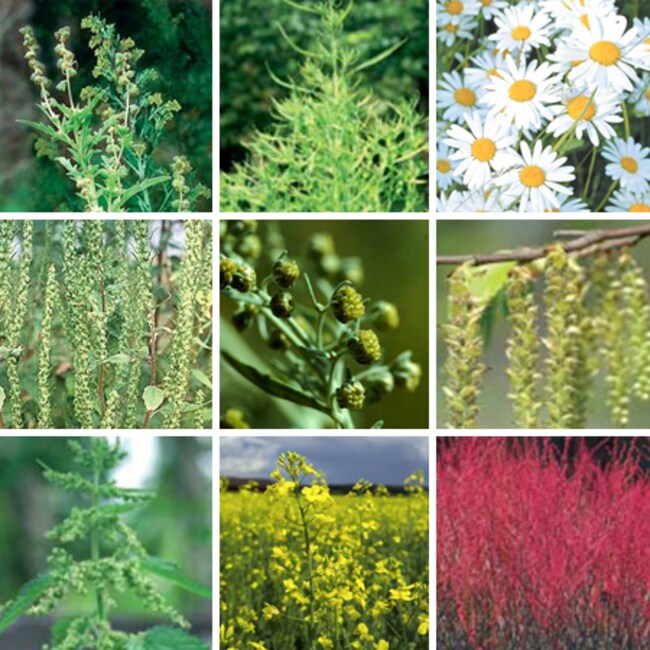Search Thermo Fisher Scientific
- Contact Us
- Quick Order
-
Don't have an account ? Create Account
Search Thermo Fisher Scientific

| Scientific Name | Chenopodium album |
| Regulatory Status | FDA Cleared |
| Code Type | Weed |
| Common Name | Goosefoot, Lamb’s quarters |
| Quantity | 16 Tests |
| Code | w10 |
| Unit Size | Each |
| Scientific Name | Taraxacum vulgare |
| Regulatory Status | FDA Cleared |
| Code Type | Weed |
| Common Name | Dandelion |
| Quantity | 16 Tests |
| Code | w8 |
| Unit Size | Each |
| Scientific Name | Ambrosia trifida |
| Regulatory Status | FDA Cleared |
| Code Type | Weed |
| Common Name | Giant ragweed |
| Quantity | 16 Tests |
| Code | w3 |
| Unit Size | Each |
| Scientific Name | Plantago lanceolata |
| Regulatory Status | FDA Cleared |
| Code Type | Weed |
| Common Name | Plantain (English), Ribwort |
| Quantity | 16 Tests |
| Code | w9 |
| Unit Size | Each |
| Scientific Name | Rumex crispus |
| Regulatory Status | ASR |
| Code Type | Weed |
| Common Name | Yellow dock |
| Quantity | 10 Tests |
| Code | Rw23 |
| Unit Size | Each |
| Scientific Name | Medicago sativa |
| Regulatory Status | ASR |
| Code Type | Weed |
| Common Name | Alfalfa |
| Quantity | 10 Tests |
| Code | Rw45 |
| Unit Size | Each |
| Scientific Name | Amaranthus palmeri |
| Regulatory Status | ASR |
| Code Type | Weed |
| Common Name | Careless weed |
| Quantity | 10 Tests |
| Code | Rw82 |
| Unit Size | Each |
| Scientific Name | Eupatorium capillifolium |
| Regulatory Status | ASR |
| Code Type | Weed |
| Common Name | Dog fennel |
| Quantity | 10 Tests |
| Code | Rw46 |
| Unit Size | Each |
| Scientific Name | Brassica napus |
| Regulatory Status | ASR |
| Code Type | Weed |
| Common Name | Rape |
| Quantity | 10 Tests |
| Code | Rw203 |
| Unit Size | Each |
| Scientific Name | Helianthus annuus |
| Regulatory Status | ASR |
| Code Type | Weed |
| Common Name | Sunflower |
| Quantity | 10 Tests |
| Code | Rw204 |
| Unit Size | Each |
| Catalog Number | Specifications | Unit Size | Common Name | Scientific Name | Code | Quantity | Price (ARS) | ||||||||||||||||||||||||||||||||||||||||||||||||||||||||||||||||||||||||||||||||||||||||||||||||||||||||||
|---|---|---|---|---|---|---|---|---|---|---|---|---|---|---|---|---|---|---|---|---|---|---|---|---|---|---|---|---|---|---|---|---|---|---|---|---|---|---|---|---|---|---|---|---|---|---|---|---|---|---|---|---|---|---|---|---|---|---|---|---|---|---|---|---|---|---|---|---|---|---|---|---|---|---|---|---|---|---|---|---|---|---|---|---|---|---|---|---|---|---|---|---|---|---|---|---|---|---|---|---|---|---|---|---|---|---|---|---|---|---|---|---|---|
| 14415701 | Each | Goosefoot, Lamb’s quarters | Chenopodium album | w10 | 16 Tests | Contact Us › | |||||||||||||||||||||||||||||||||||||||||||||||||||||||||||||||||||||||||||||||||||||||||||||||||||||||||||
| |||||||||||||||||||||||||||||||||||||||||||||||||||||||||||||||||||||||||||||||||||||||||||||||||||||||||||||||||
| 14415501 | Each | Dandelion | Taraxacum vulgare | w8 | 16 Tests | Contact Us › | |||||||||||||||||||||||||||||||||||||||||||||||||||||||||||||||||||||||||||||||||||||||||||||||||||||||||||
| |||||||||||||||||||||||||||||||||||||||||||||||||||||||||||||||||||||||||||||||||||||||||||||||||||||||||||||||||
| 14415301 | Each | Giant ragweed | Ambrosia trifida | w3 | 16 Tests | Contact Us › | |||||||||||||||||||||||||||||||||||||||||||||||||||||||||||||||||||||||||||||||||||||||||||||||||||||||||||
| |||||||||||||||||||||||||||||||||||||||||||||||||||||||||||||||||||||||||||||||||||||||||||||||||||||||||||||||||
| 14415601 | Each | Plantain (English), Ribwort | Plantago lanceolata | w9 | 16 Tests | Contact Us › | |||||||||||||||||||||||||||||||||||||||||||||||||||||||||||||||||||||||||||||||||||||||||||||||||||||||||||
| |||||||||||||||||||||||||||||||||||||||||||||||||||||||||||||||||||||||||||||||||||||||||||||||||||||||||||||||||
| 14495010 | Each | Yellow dock | Rumex crispus | Rw23 | 10 Tests | Contact Us › | |||||||||||||||||||||||||||||||||||||||||||||||||||||||||||||||||||||||||||||||||||||||||||||||||||||||||||
| |||||||||||||||||||||||||||||||||||||||||||||||||||||||||||||||||||||||||||||||||||||||||||||||||||||||||||||||||
| 14495110 | Each | Alfalfa | Medicago sativa | Rw45 | 10 Tests | Contact Us › | |||||||||||||||||||||||||||||||||||||||||||||||||||||||||||||||||||||||||||||||||||||||||||||||||||||||||||
| |||||||||||||||||||||||||||||||||||||||||||||||||||||||||||||||||||||||||||||||||||||||||||||||||||||||||||||||||
| 14495310 | Each | Careless weed | Amaranthus palmeri | Rw82 | 10 Tests | Contact Us › | |||||||||||||||||||||||||||||||||||||||||||||||||||||||||||||||||||||||||||||||||||||||||||||||||||||||||||
| |||||||||||||||||||||||||||||||||||||||||||||||||||||||||||||||||||||||||||||||||||||||||||||||||||||||||||||||||
| 14495210 | Each | Dog fennel | Eupatorium capillifolium | Rw46 | 10 Tests | Contact Us › | |||||||||||||||||||||||||||||||||||||||||||||||||||||||||||||||||||||||||||||||||||||||||||||||||||||||||||
| |||||||||||||||||||||||||||||||||||||||||||||||||||||||||||||||||||||||||||||||||||||||||||||||||||||||||||||||||
| 14502410 | Each | Rape | Brassica napus | Rw203 | 10 Tests | Contact Us › | |||||||||||||||||||||||||||||||||||||||||||||||||||||||||||||||||||||||||||||||||||||||||||||||||||||||||||
| |||||||||||||||||||||||||||||||||||||||||||||||||||||||||||||||||||||||||||||||||||||||||||||||||||||||||||||||||
| 14502510 | Each | Sunflower | Helianthus annuus | Rw204 | 10 Tests | Contact Us › | |||||||||||||||||||||||||||||||||||||||||||||||||||||||||||||||||||||||||||||||||||||||||||||||||||||||||||
| |||||||||||||||||||||||||||||||||||||||||||||||||||||||||||||||||||||||||||||||||||||||||||||||||||||||||||||||||